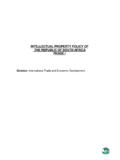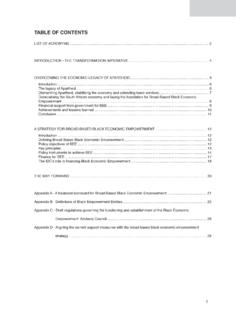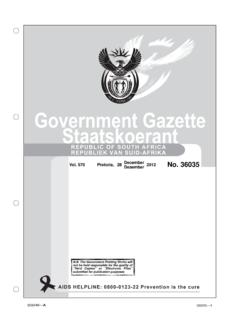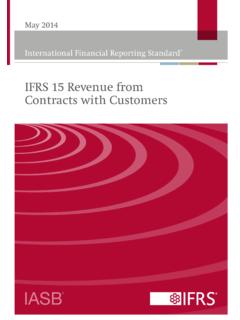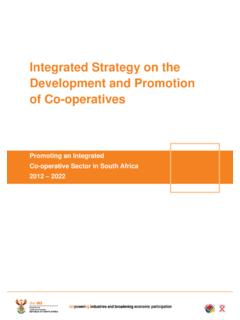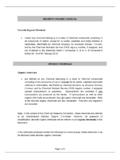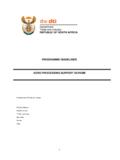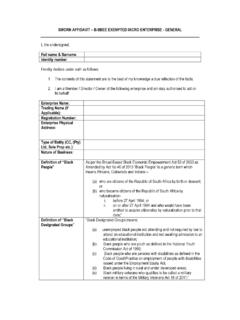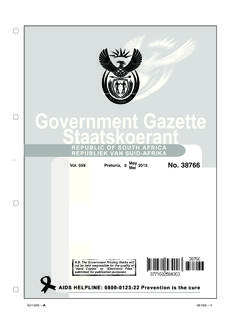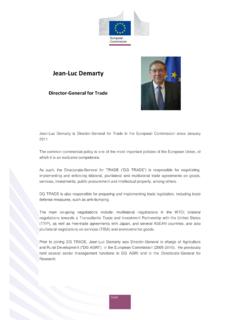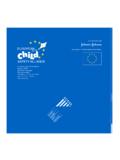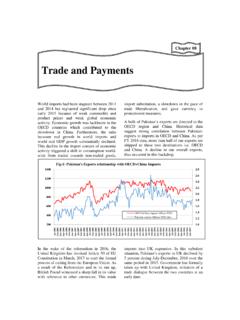Transcription of South Africa s Trade Policy and Strategy Framework
1 South Africa s Trade Policy and Strategy FrameworkDr Brendan VickersChief Director: Research and PolicyInternational Trade and Economic Development (ITED)Presentation to the Select Committee on Trade and International Relations30 July 20142SA Policy Context SA Government s broad national development Strategy aims to accelerate growth along a path that generates sustainable, decent jobs to address apartheid legacies. Strategy elaborated in the NDP and NGP. NIPF and IPAP are central components of this Strategy and seek to encourage and upgrade value-added, labour-absorbing industrial production. Trade Policy is an instrument of industrial Policy .
2 Must support industrial development and upgrading, employment growth and increased value-added s Trade Policy : Setting the Scene SA is a relatively open economy, only moderately protected by tariffs. Simple average MFN applied tariff: (down from 23% in the 1990s). 56% duties are set at 0% Compared to our trading partners, the tariff regime is transparent and not overly complex ( no NTBs). WTO Services commitments on par with OECD countries. SA ranks amongst the most open jurisdictions for FDI in the world and provides strong protection to investors in line with high international s Trade Reform Experience Extensive tariff liberalisation since 1994.
3 BUT while SA exports increased significantly, the basket of export goods, with some notable exceptions, remains largely unchanged. SA exports continue to be dominated by commodities, except in African markets. Labour-intensive production has contracted due to imports. Bias towards capital and high skill-intensive growth. Hence NDP, NGP and IPAP call for developmental Trade policies to encourage and upgrade value-added, labour-absorbing industrial s Approach to Tariff Reform International experience demonstrates the importance of a strategic approach to tariff Policy ( as part of industrial Policy , and pursued gradually and selectively to support industrial development).
4 An evidence-based, case-by-case assessment will inform tariff changes in SA (no a prioriposition). Vital role for ITAC. Tariffs on mature upstream input industries could be reduced or removed to lower the costs for downstream, labour-creating manufacturing. Tariffs on downstream industries with employment or value-addition potential could be retained or raised to ensure sustainability and job Trade Agreements SACU SADC free Trade Area (FTA) since 2008 SA-EU Trade , Development and Cooperation agreement ; now revised as part of Economic Partnership agreement SACU-European free Trade Association (EFTA) FTA SACU-Mercosur Preferential Trade agreement (not yet ratified) SACU-India Preferential Trade agreement (under negotiation) SADC-EAC-COMESA T-FTA (under negotiation) SA benefits from Generalised System of Preferences and African Growth and Opportunity Act77 SA champions developmental integration in SACU, SADC, T-FTA and C-FTA.
5 Addresses shortcomings and relevance of mechanical sequencing of Viner stages in developing regions. Argues major barriers to intra-regional Trade often inadequate infrastructure and underdeveloped production structures rather than tariffs or regulatory barriers. Concludes integration processes must be complemented and preceded by advances in cooperation and coordination programmes to address real economy constraints. Three pillars: market integration; infrastructure; Policy coordination, especially to build regional Approach to Regional Integration88 Formed in 1910, SACU is oldest functioning CU in the world. Membership: SA and Botswana, Lesotho, Namibia and Swaziland (BLNS).
6 SACU has adopted a work programme focusing on five areas: Promote regional industrial development; Trade facilitation; Review revenue sharing arrangement; Establish common institutions (while preserving Policy space for Member States); Unified engagement in Trade negotiations with third African Customs Union (SACU)99 SADC FTA established in 2008 and implemented by 2012. Currently 92% product lines traded at zero %. Priority is to consolidate FTA based on recommendations of the Ministerial Task Force (August 2010) as a prerequisite to further consideration of the SADC CU. Consolidation includes: accession by non-Members; outstanding commitments; NTBs; rules of origin, etc.
7 Need to focus on infrastructure and sectoral coordination. SADC CU will not address the real economy constraints to higher levels of intra-regional Trade and investment. SADC CU will present profound political, Policy , legal and institutional challenges ( common external tariff, common Trade and industrial policies).SADC FTASADC-EAC-COMESA T-FTA T-FTA negotiations underway: behind schedule (2014 deadline) Key principle agreed: Negotiations among T-FTA members with no preferential arrangements in place (no reopening SADC TP). In effect SACU will negotiate tariff concessions with non-SADC Members of T-FTA (notably EAC and Egypt). Agreed Modality for offers: 60% of tariff lines duty- free at entry into force; 25% to be negotiated; 5-8 years implementation.
8 Key challenge is Rules of Origin must ensure benefits of preferences accrue to T-FTA Partners, not third countries. SA is developing its market access offers and requests, and texts, in NEDLAC, as basis for the SACU position. Work underway on N-S Corridor and industrial PTA PTA negotiations since 2007 with progress made on legal texts (Main agreement and Safeguards). Dispute Settlement text almost agreed. Market access requests exchanged in December 2011. Concerns from constituencies include India s request in sensitive sectors (clothing and chemicals) and that NTBs will diminish value of Indian offer. Ministers agreed in January 2013 to a reduced level of tariff exchange (level to be agreed).
9 PTA to be building block to incrementally grow Trade . Preparation of SA offer re-started in EPA EPA initialed in July 2014 ahead of 1 Oct 2014 deadline Improves TDCA market access for SA agricultural exports, notably wine, ethanol and sugar EU to eliminate all agricultural export subsidies on goods destined to SACU Bilateral safeguard and Special Safeguard for SACU Agric New Rules of Origin to assist clothing exports and for regional cumulation agreement on Geographical Indicators (GIs) including protection of Rooibos , Honeybush and Karoo Lamb Non-binding cooperation on new generation Trade issuesAfrica Growth and Opportunity Act AGOA has assisted in growing Trade between SA/SSA and the US, and has generated goodwill.
10 SSA calling for a 15-year extension of AGOA beyond expiry in September 2015. Bipartisan and Administration support in US to extend. Some questions about SA and idea of graduation. We advocate to build on existing arrangement, avoid any adjustment that would undermine relationship. AGOA should be strengthened to support Africa s regional integration agenda more directly. Priority is to build a virtuous cycle of Trade and investment. 1314 Changing Landscape in Global Trade Prior to WTO s Bali Ministerial Conference, Doha Round had been at an impasse since July 2008. Major economies turning away from multilateralism and Doha Round, reinforced by strong push in RTAs (TPP and TTIP).
